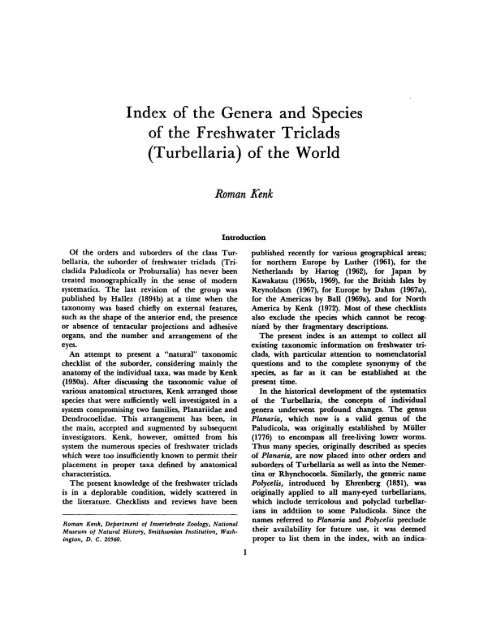of the Genera and Species of the Freshwater Triclads - Smithsonian ...
of the Genera and Species of the Freshwater Triclads - Smithsonian ...
of the Genera and Species of the Freshwater Triclads - Smithsonian ...
You also want an ePaper? Increase the reach of your titles
YUMPU automatically turns print PDFs into web optimized ePapers that Google loves.
Index <strong>of</strong> <strong>the</strong> <strong>Genera</strong> <strong>and</strong> <strong>Species</strong><br />
<strong>of</strong> <strong>the</strong> <strong>Freshwater</strong> <strong>Triclads</strong><br />
(Turbellaria) <strong>of</strong> <strong>the</strong> World<br />
Of <strong>the</strong> orders <strong>and</strong> suborders <strong>of</strong> <strong>the</strong> class Turbellaria,<br />
<strong>the</strong> suborder <strong>of</strong> freshwater triclads (Tricladida<br />
Paludicola or Probursalia) has never been<br />
treated monographically in <strong>the</strong> sense <strong>of</strong> modern<br />
systematics. The last revision <strong>of</strong> <strong>the</strong> group was<br />
published by Hallez (1894b) at a time when <strong>the</strong><br />
taxonomy was based chiefly on external features,<br />
such as <strong>the</strong> shape <strong>of</strong> <strong>the</strong> anterior end, <strong>the</strong> presence<br />
or absence <strong>of</strong> tentacular projections <strong>and</strong> adhesive<br />
organs, <strong>and</strong> <strong>the</strong> number <strong>and</strong> arrangement <strong>of</strong> <strong>the</strong><br />
eyes.<br />
An attempt to present a "natural" taxonomic<br />
checklist <strong>of</strong> <strong>the</strong> suborder, considering mainly <strong>the</strong><br />
anatomy <strong>of</strong> <strong>the</strong> individual taxa, was made by Kenk<br />
(1930a). After discussing <strong>the</strong> taxonomic value <strong>of</strong><br />
various anatomical structures, Kenk arranged those<br />
species that were sufficiently well investigated in a<br />
system compromising two families, Planariidae <strong>and</strong><br />
Dendrocoelidae. This arrangement has been, in<br />
<strong>the</strong> main, accepted <strong>and</strong> augmented by subsequent<br />
investigators. Kenk, however, omitted from his<br />
system <strong>the</strong> numerous species <strong>of</strong> freshwater triclads<br />
which were too insufficiently known to permit <strong>the</strong>ir<br />
placement in proper taxa defined by anatomical<br />
characteristics.<br />
The present knowledge <strong>of</strong> <strong>the</strong> freshwater triclads<br />
is in a deplorable condition, widely scattered in<br />
<strong>the</strong> literature. Checklists <strong>and</strong> reviews have been<br />
Roman Kenk, Department <strong>of</strong> Invertebrate Zoology, National<br />
Museum <strong>of</strong> Natural History, <strong>Smithsonian</strong> Institution, Washington,<br />
D. C. 20560.<br />
Roman Kenk<br />
Introduction<br />
1<br />
published recently for various geographical areas;<br />
for nor<strong>the</strong>rn Europe by Lu<strong>the</strong>r (1961), for <strong>the</strong><br />
Ne<strong>the</strong>rl<strong>and</strong>s by Hartog (1962), for Japan by<br />
Kawakatsu (1965b, 1969), for <strong>the</strong> British Isles by<br />
Reynoldson (1967), for Europe by Dahm (1967a),<br />
for <strong>the</strong> Americas by Ball (1969a), <strong>and</strong> for North<br />
America by Kenk (1972). Most <strong>of</strong> <strong>the</strong>se checklists<br />
also exclude <strong>the</strong> species which cannot be recognized<br />
by <strong>the</strong>r fragmentary descriptions.<br />
The present index is an attempt to collect all<br />
existing taxonomic information on freshwater triclads,<br />
with particular attention to nomendatorial<br />
questions <strong>and</strong> to <strong>the</strong> complete synonymy <strong>of</strong> <strong>the</strong><br />
species, as far as it can be established at <strong>the</strong><br />
present time.<br />
In <strong>the</strong> historical development <strong>of</strong> <strong>the</strong> systematics<br />
<strong>of</strong> <strong>the</strong> Turbellaria, <strong>the</strong> concepts <strong>of</strong> individual<br />
genera underwent pr<strong>of</strong>ound changes. The genus<br />
Planaria, which now is a valid genus <strong>of</strong> <strong>the</strong><br />
Paludicola, was originally established by Miiller<br />
(1776) to encompass all free-living lower worms.<br />
Thus many species, originally described as species<br />
<strong>of</strong> Planaria, are now placed into o<strong>the</strong>r orders <strong>and</strong><br />
suborders <strong>of</strong> Turbellaria as well as into <strong>the</strong> Nemertina<br />
or Rhynchocoela. Similarly, <strong>the</strong> generic name<br />
Polycelis, introduced by Ehrenberg (1831), was<br />
originally applied to all many-eyed turbellarians,<br />
which include terricolous <strong>and</strong> polyclad turbellarians<br />
in addtiion to some Paludicola. Since <strong>the</strong><br />
names referred to Planaria <strong>and</strong> Polycelis preclude<br />
<strong>the</strong>ir availability for future use, it was deemed<br />
proper to list <strong>the</strong>m in <strong>the</strong> index, with an indica-

















